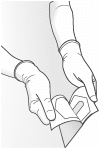The role of packaging size on contamination rates during simulated presentation to a sterile field
- PMID: 25003738
- PMCID: PMC4086713
- DOI: 10.1371/journal.pone.0100414
The role of packaging size on contamination rates during simulated presentation to a sterile field
Abstract
Objective: The objective of this study was to assess the impact of package size on the contact between medical devices and non-sterile surfaces (i.e. the hands of the practitioner and the outside of the package) during aseptic presentation to a simulated sterile field. Rationale for this objective stems from the decades-long problem of hospital-acquired infections. This work approaches the problem from a unique perspective, namely packaging size.
Design: Randomized complete block design with subsampling.
Setting: Research study conducted at professional conferences for surgical technologists and nursing professionals.
Participants: Ninety-seven healthcare providers, primarily surgical technologists and nurses.
Methods: Participants were gloved and asked to present the contents of six pouches of three different sizes to a simulated sterile field. The exterior of pouches and gloves of participants were coated with a simulated contaminant prior to each opening trial. After presentation to the simulated sterile field, the presence of the contaminant on package contents was recorded as indicative of contact with non-sterile surfaces and analyzed in a binary fashion using a generalized linear mixed model.
Results: Recruited subjects were 26-64 years of age (81 females, 16 males), with 2.5-44 years of professional experience. Results indicated a significant main effect of pouch size on contact rate of package contents (P = 0.0108), whereby larger pouches induced greater rates of contact than smaller pouches (estimates±SEM: 14.7±2.9% vs. 6.0±1.7%, respectively).
Discussion and conclusion: This study utilized novel methodologies which simulate contamination in aseptic presentation. Results of this work indicate that increased contamination rates are associated with larger pouches when compared to smaller pouches. The results add to a growing body of research which investigate packaging's role in serving as a pathway for product contamination during aseptic presentation. Future work should investigate other packaging design factors (e.g. material, rigidity, and closure systems) and their role in contamination.
Conflict of interest statement
Figures



References
-
- Scott RD, Douglas R (2009) The direct medical costs of healthcare-associated infections in US hospitals and the benefits of prevention.
-
- Malpiedi P, Peterson K, Soe M, Edwards J (2011) National and State Healthcare-Associated Infection Standardized Infection Ratio Report.
-
- Stone P, Larson E, Kawar L (2002) A systematic audit of economic evidence linking nosocomial infections and infection control interventions: 1990–2000. American Journal of Infection Control 30: 145–152. - PubMed
Publication types
MeSH terms
LinkOut - more resources
Full Text Sources
Other Literature Sources

